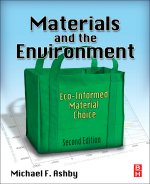Materials and the Environment

Addressing the growing global concern for sustainable engineering, Materials and the Environment, 2e is the only book devoted exclusively to the environmental aspects of materials.
It explains the ways in which we depend on and use materials and the consequences these have, and it introduces methods for thinking about and designing with materials within the context of minimizing environmental impact.
Along with its noted in-depth coverage of material consumption, the material life-cycle, selection strategies, and legislative aspects, the second edition includes new case studies, important new chapters on Materials for Low Carbon Power and Material Efficiency, all illustrated by in-text examples and expanded exercises. This book is intended for instructors and students as well as materials engineers and product designers who need to consider the environmental implications of materials in their designs.
New to this edition
New to this edition of Materials and the Environment are:
- New chapter of Case Studies of Eco-audits illustrating the rapid audit method
- New chapter on Materials for Low Carbon Power examines the consequences for materials supply of a major shift from fossil-fuel based power to power from renewables
- New chapter exploring Material Efficiency, or design and management for manufacture to provide the services we need with the least production of materials
- Recent news-clips from the world press that help place materials issues into a broader context.are incorporated into all chapters
- End-of-chapter exercises have been greatly expanded
- The datasheets of Chapter 15 have been updated and expanded to include natural and man-made fibers
Readership
Materials and the Environment is suited to students of Engineering, Materials Science and Industrial/Product Design; Materials & Industrial Engineers; Product Designers
Key Features
Key features of Materials and the Environment include:
- Introduces methods and tools for thinking about and designing with materials within the context of their role in products and the environmental consequences
- Contains numerous case studies showing how the methods discussed in the book can be applied to real-world situations
- Includes full-color data sheets for 40 of the most widely used materials, featuring such environmentally relevant information as their annual production and reserves, embodied energy and process energies, carbon footprints, and recycling data
https://shop.elsevier.com/books/materials-and-the-environment/ashby/978-0-12-821521-0
Terms
While we only use edited and approved content for Azthena
answers, it may on occasions provide incorrect responses.
Please confirm any data provided with the related suppliers or
authors. We do not provide medical advice, if you search for
medical information you must always consult a medical
professional before acting on any information provided.
Your questions, but not your email details will be shared with
OpenAI and retained for 30 days in accordance with their
privacy principles.
Please do not ask questions that use sensitive or confidential
information.
Read the full Terms & Conditions.